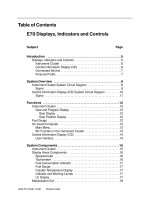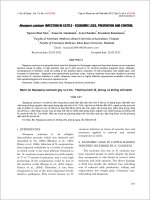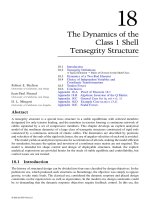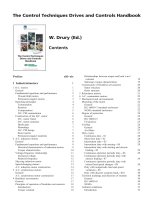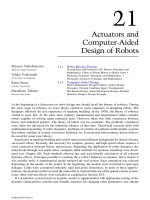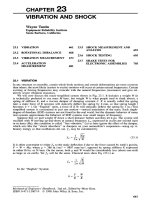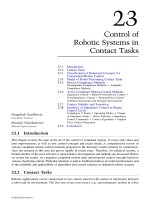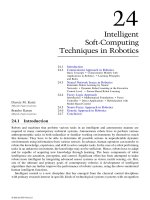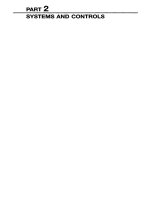Vibration and control
Bạn đang xem bản rút gọn của tài liệu. Xem và tải ngay bản đầy đủ của tài liệu tại đây (3.03 MB, 382 trang )
Vibration with Control
Vibration with Control D. J. Inman
©2006JohnWiley&Sons,Ltd. ISBN: 0-470-01051-7
Vibration with Control
Daniel J. Inman
Virginia Tech, USA
Copyright © 2006 John Wiley & Sons Ltd, The Atrium, Southern Gate, Chichester,
West Sussex PO19 8SQ, England
Telephone (+44) 1243 779777
Email (for orders and customer service enquiries):
Visit our Home Page on www.wiley.com
All Rights Reserved. No part of this publication may be reproduced, stored in a retrieval system or transmitted
in any form or by any means, electronic, mechanical, photocopying, recording, scanning or otherwise, except
under the terms of the Copyright, Designs and Patents Act 1988 or under the terms of a licence issued by the
Copyright Licensing Agency Ltd, 90 Tottenham Court Road, London W1T 4LP, UK, without the permission in
writing of the Publisher. Requests to the Publisher should be addressed to the Permissions Department, John
Wiley & Sons Ltd, The Atrium, Southern Gate, Chichester, West Sussex PO19 8SQ, England, or emailed to
, or faxed to (+44) 1243 770620.
Designations used by companies to distinguish their products are often claimed as trademarks. All brand names
and product names used in this book are trade names, service marks, trademarks or registered trademarks of their
respective owners. The Publisher is not associated with any product or vendor mentioned in this book.
This publication is designed to provide accurate and authoritative information in regard to the subject matter
covered. It is sold on the understanding that the Publisher is not engaged in rendering professional services. If
professional advice or other expert assistance is required, the services of a competent professional
should be sought.
Other Wiley Editorial Offices
John Wiley & Sons Inc., 111 River Street, Hoboken, NJ 07030, USA
Jossey-Bass, 989 Market Street, San Francisco, CA 94103-1741, USA
Wiley-VCH Verlag GmbH, Boschstr. 12, D-69469 Weinheim, Germany
John Wiley & Sons Australia Ltd, 42 McDougall Street, Milton, Queensland 4064, Australia
John Wiley & Sons (Asia) Pte Ltd, 2 Clementi Loop #02-01, Jin Xing Distripark, Singapore 129809
John Wiley & Sons Canada Ltd, 22 Worcester Road, Etobicoke, Ontario, Canada M9W 1L1
Wiley also publishes its books in a variety of electronic formats. Some content that appears in print may not be
available in electronic books.
Library of Congress Cataloging in Publication Data
Inman, D. J.
Vibration with control / Daniel J. Inman.
p. cm.
Includes bibliographical references and index.
ISBN-13 978-0-470-01051-8 (HB)
ISBN-10 0-470-01051-7 (cloth : alk. paper)
1. Damping (Mechanics). 2. Vibration. I. Title.
TA355.I523 2006
620.3—dc22 2006005568
British Library Cataloguing in Publication Data
A catalogue record for this book is available from the British Library
ISBN-13 978-0-470-01051-8 (HB)
ISBN-10 0-470-01051-7 (HB)
Typeset in 10/12pt Times by Integra Software Services Pvt. Ltd, Pondicherry, India
Printed and bound in Great Britain by Antony Rowe Ltd, Chippenham, Wiltshire
This book is printed on acid-free paper responsibly manufactured from sustainable forestry
in which at least two trees are planted for each one used for paper production.
Contents
Preface xi
1 Single-degree-of-freedom Systems 1
1.1 Introduction 1
1.2 Spring–Mass System 1
1.3 Spring–Mass–Damper System 4
1.4 Forced Response 8
1.5 Transfer Functions and Frequency Methods 14
1.6 Measurement and Testing 19
1.7 Stability 22
1.8 Design and Control of Vibrations 24
1.9 Nonlinear Vibrations 27
1.10 Computing and Simulation in Matlab 29
Chapter Notes 35
References 35
Problems 36
2 Lumped-parameter Models 39
2.1 Introduction 39
2.2 Classifications of Systems 42
2.3 Feedback Control Systems 44
2.4 Examples 45
2.5 Experimental Models 49
2.6 Influence Methods 50
2.7 Nonlinear Models and Equilibrium 52
Chapter Notes 54
References 55
Problems 55
3 Matrices and the Free Response 57
3.1 Introduction 57
3.2 Eigenvalues and Eigenvectors 58
3.3 Natural Frequencies and Mode Shapes 63
vi CONTENTS
3.4 Canonical Forms 71
3.5 Lambda Matrices 74
3.6 Oscillation Results 77
3.7 Eigenvalue Estimates 81
3.8 Computation Eigenvalue Problems in Matlab 88
3.9 Numerical Simulation of the Time Response in Matlab 91
Chapter Notes 93
References 94
Problems 95
4 Stability 99
4.1 Introduction 99
4.2 Lyapunov Stability 99
4.3 Conservative Systems 101
4.4 Systems with Damping 103
4.5 Semidefinite Damping 103
4.6 Gyroscopic Systems 104
4.7 Damped Gyroscopic Systems 106
4.8 Circulatory Systems 107
4.9 Asymmetric Systems 109
4.10 Feedback Systems 113
4.11 Stability in State Space 116
4.12 Stability Boundaries 118
Chapter Notes 119
References 120
Problems 121
5 Forced Response of Lumped-parameter Systems 123
5.1 Introduction 123
5.2 Response via State-space Methods 123
5.3 Decoupling Conditions and Modal Analysis 128
5.4 Response of Systems with Damping 132
5.5 Bounded-input, Bounded-output Stability 134
5.6 Response Bounds 136
5.7 Frequency Response Methods 138
5.8 Numerical Simulation in Matlab 140
Chapter Notes 142
References 142
Problems 143
6 Design Considerations 145
6.1 Introduction 145
6.2 Isolators and Absorbers 145
6.3 Optimization Methods 148
6.4 Damping Design 153
6.5 Design Sensitivity and Redesign 155
6.6 Passive and Active Control 158
CONTENTS vii
6.7 Design Specifications 160
6.8 Model Reduction 161
Chapter Notes 164
References 165
Problems 165
7 Control of Vibrations 169
7.1 Introduction 169
7.2 Controllability and Observability 171
7.3 Eigenstructure Assignment 176
7.4 Optimal Control 179
7.5 Observers (Estimators) 185
7.6 Realization 190
7.7 Reduced-order Modeling 192
7.8 Modal Control in State Space 198
7.9 Modal Control in Physical Space 202
7.10 Robustness 206
7.11 Positive Position Feedback 208
7.12 Matlab Commands for Control Calculations 211
Chapter Notes 216
References 217
Problems 218
8 Modal Testing 221
8.1 Introduction 221
8.2 Measurement Hardware 222
8.3 Digital Signal Processing 225
8.4 Random Signal Analysis 229
8.5 Modal Data Extraction (Frequency Domain) 232
8.6 Modal Data Extraction (Time Domain) 235
8.7 Model Identification 241
8.8 Model Updating 243
Chapter Notes 244
References 245
Problems 246
9 Distributed-parameter Models 249
9.1 Introduction 249
9.2 Vibration of Strings 249
9.3 Rods and Bars 256
9.4 Vibration of Beams 260
9.5 Membranes and Plates 264
9.6 Layered Materials 268
9.7 Viscous Damping 270
Chapter Notes 271
References 272
Problems 273
viii CONTENTS
10 Formal Methods of Solution 275
10.1 Introduction 275
10.2 Boundary Value Problems and Eigenfunctions 275
10.3 Modal Analysis of the Free Response 278
10.4 Modal Analysis in Damped Systems 280
10.5 Transform Methods 282
10.6 Green’s Functions 284
Chapter Notes 288
References 289
Problems 289
11 Operators and the Free Response 291
11.1 Introduction 291
11.2 Hilbert Spaces 291
11.3 Expansion Theorems 296
11.4 Linear Operators 297
11.5 Compact Operators 303
11.6 Theoretical Modal Analysis 304
11.7 Eigenvalue Estimates 306
11.8 Enclosure Theorems 308
11.9 Oscillation Theory 310
Chapter Notes 312
References 313
Problems 313
12 Forced Response and Control 315
12.1 Introduction 315
12.2 Response by Modal Analysis 315
12.3 Modal Design Criteria 318
12.4 Combined Dynamical Systems 320
12.5 Passive Control and Design 324
12.6 Distributed Modal Control 326
12.7 Nonmodal Distributed Control 328
12.8 State-space Control Analysis 329
Chapter Notes 330
References 331
Problems 332
13 Approximations of Distributed-parameter Models 333
13.1 Introduction 333
13.2 Modal Truncation 333
13.3 Rayleigh–Ritz–Galerkin Approximations 335
13.4 Finite Element Method 337
13.5 Substructure Analysis 342
13.6 Truncation in the Presence of Control 345
13.7 Impedance Method of Truncation and Control 352
CONTENTS ix
Chapter Notes 354
References 355
Problems 355
A Comments on Units 357
B Supplementary Mathematics 361
Index 365
Preface
Advance-level vibration topics are presented here, including lumped-mass and distributed-
mass systems in the context of the appropriate mathematics, along with topics from control
that are useful in vibration analysis and design. This text is intended for use in a second
course in vibration, or in a combined course in vibration and control. This book is also
intended as a reference for the field of structural control and could be used as a text in
structural control. Control topics are introduced at beginner level, with no knowledge of
controls needed to read the book.
The heart of this manuscript was first developed in the early 1980s and published in 1989
under the title Vibration with Control, Measurement and Stability. That book went out of
print in 1994. However, the text remained in use at several universities, and all used copies
seem to have disappeared from online sources in about 1998. Since then I have had yearly
requests for copying rights. Hence, at the suggestions of colleagues, I have revised the older
book to produce this text. The manuscript is currently being used in a graduate course at
Virginia Tech in the Mechanical Engineering Department. As such, presentation materials
for each chapter and a complete solutions manual are available for use by instructors.
The text is an attempt to place vibration and control on a firm mathematical basis and
connect the disciplines of vibration, linear algebra, matrix computations, control, and applied
functional analysis. Each chapter ends with notes on further references and suggests where
more detailed accounts can be found. In this way I hope to capture a ‘big picture’ approach
without producing an overly large book. The first chapter presents a quick introduction
using single-degree-of-freedom systems (second-order ordinary differential equations) to
the following chapters, which extend these concepts to multiple-degree-of-freedom systems
(matrix theory, systems of ordinary differential equations) and distributed-parameter systems
(partial differential equations and boundary value problems). Numerical simulations and
matrix computations are also presented through the use of Matlab
TM
. New material has
been added on the use of Matlab, and a brief introduction to nonlinear vibration is given.
New problems and examples have been added, as well as a few new topics.
ACKNOWLEDGMENTS
I would like to thank Jamil M. Renno, a PhD student, for reading the final manuscript
and sorting out several typos and numerical errors. In addition, Drs T. Michael Seigler,
xii PREFACE
Kaihong Wang, and Henry H. Sodano are owed special thanks for helping with the figures.
I would also like to thank my past PhD students who have used the earlier version of the book,
as well as Pablo Tarazaga, Dr Curt Kothera, M. Austin Creasy, and Armaghan Salehian who
read the draft and made wonderful corrections and suggestions. Professor Daniel P. Hess
of the University of South Florida provided invaluable suggestions and comments for which
I am grateful. I would like to thank Ms Vanessa McCoy who retyped the manuscript from
the hard copy of the previous version of this book and thus allowed me to finish writing
electronically.
Thanks are also owed to Wendy Hunter of Wiley for the opportunity to publish this
manuscript and the encouragement to finish it. I would also like to extend my thanks and
appreciation to my wife Cathy Little, son Daniel, and daughters Jennifer and Angela (and
their families) for putting up with my absence while I worked on this manuscript.
Daniel J. Inman
1
Single-degree-of-freedom
Systems
1.1 INTRODUCTION
In this chapter the vibration of a single-degree-of-freedom system will be analyzed and
reviewed. Analysis, measurement, design, and control of a single-degree-of-freedom system
(often abbreviated SDOF) is discussed. The concepts developed in this chapter constitute an
introductory review of vibrations and serve as an introduction for extending these concepts
to more complex systems in later chapters. In addition, basic ideas relating to measurement
and control of vibrations are introduced that will later be extended to multiple-degree-
of-freedom systems and distributed-parameter systems. This chapter is intended to be a
review of vibration basics and an introduction to a more formal and general analysis for
more complicated models in the following chapters.
Vibration technology has grown and taken on a more interdisciplinary nature. This has
been caused by more demanding performance criteria and design specifications for all types
of machines and structures. Hence, in addition to the standard material usually found in
introductory chapters of vibration and structural dynamics texts, several topics from control
theory and vibration measurement theory are presented. This material is included not to
train the reader in control methods (the interested student should study control and system
theory texts) but rather to point out some useful connections between vibration and control
as related disciplines. In addition, structural control has become an important discipline
requiring the coalescence of vibration and control topics. A brief introduction to nonlinear
SDOF systems and numerical simulation is also presented.
1.2 SPRING–MASS SYSTEM
Simple harmonic motion, or oscillation, is exhibited by structures that have elastic restoring
forces. Such systems can be modeled, in some situations, by a spring–mass schematic, as
illustrated in Figure 1.1. This constitutes the most basic vibration model of a structure and can
be used successfully to describe a surprising number of devices, machines, and structures.
The methods presented here for solving such a simple mathematical model may seem to be
Vibration with Control D. J. Inman
©2006JohnWiley&Sons,Ltd. ISBN: 0-470-01051-7
2 SINGLE-DEGREE-OF-FREEDOM SYSTEMS
m
mg mg
k
kx kx
s
x (t )
(a) (b)
0
0
(c)
Figure 1.1 (a) Spring–mass schematic, (b) free body diagram, and (c) free body diagram of the static
spring–mass system.
more sophisticated than the problem requires. However, the purpose of the analysis is to lay
the groundwork for the analysis in the following chapters of more complex systems.
If x =xt denotes the displacement (m) of the mass m (kg) from its equilibrium position
as a function of time t (s), the equation of motion for this system becomes [upon summing
forces in Figure 1.1(b)]
m¨x +kx +x
s
−mg =0
where k is the stiffness of the spring (N/m), x
s
is the static deflection (m) of the spring
under gravity load, g is the acceleration due to gravity (m/s
2
), and the overdots denote
differentiation with respect to time. (A discussion of dimensions appears in Appendix A, and
it is assumed here that the reader understands the importance of using consistent units.) From
summing forces in the free body diagram for the static deflection of the spring [Figure 1.1(c)],
mg =kx
s
and the above equation of motion becomes
m¨xt +kxt =0 (1.1)
This last expression is the equation of motion of a single-degree-of-freedom system and is
a linear, second-order, ordinary differential equation with constant coefficients.
Figure 1.2 indicates a simple experiment for determining the spring stiffness by adding
known amounts of mass to a spring and measuring the resulting static deflection, x
s
. The
results of this static experiment can be plotted as force (mass times acceleration) versus x
s
,
the slope yielding the value of k for the linear portion of the plot. This is illustrated in
Figure 1.3.
Once m and k are determined from static experiments, Equation (1.1) can be solved to
yield the time history of the position of the mass m, given the initial position and velocity
of the mass. The form of the solution of Equation (1.1) is found from substitution of an
assumed periodic motion (from experience watching vibrating systems) of the form
xt =A sin
n
t + (1.2)
where
n
=
√
k/m is the natural frequency (rad/s). Here, the amplitude, A, and the phase
shift, , are constants of integration determined by the initial conditions.
SPRING–MASS SYSTEM 3
x
0
g
x
1
x
2
x
3
Figure 1.2 Measurement of the spring constant.
14
12
10
8
6
4
2
0
02468
Displacement, x, in mm
10 12 14 16 18
Force f
k
in Newtons
Figure 1.3 Determination of the spring constant.
The existence of a unique solution for Equation (1.1) with two specific initial conditions is
well known and is given by, for instance, Boyce and DiPrima (2000). Hence, if a solution of
the form of Equation (1.2) form is guessed and it works, then it is the solution. Fortunately,
in this case the mathematics, physics, and observation all agree.
To proceed, if x
0
is the specified initial displacement from equilibrium of mass m, and v
0
is
its specified initial velocity, simple substitution allows the constants A and to be evaluated.
The unique solution is
xt =
2
n
x
2
0
+v
2
0
2
n
sin
n
t +tan
−1
n
x
0
v
0
(1.3)
4 SINGLE-DEGREE-OF-FREEDOM SYSTEMS
Alternatively, xt can be written as
xt =
v
0
n
sin
n
t +x
0
cos
n
t (1.4)
by using a simple trigonometric identity.
A purely mathematical approach to the solution of Equation (1.1) is to assume a solution
of the form xt =A e
t
and solve for , i.e.,
m
2
e
t
+ke
t
=0
This implies that (because e
t
=0, and A =0)
2
+
k
m
=0
or that
=±j
k
m
1/2
=±
n
j
where j =−1
1/2
. Then the general solution becomes
xt =A
1
e
−
n
jt
+A
2
e
n
jt
(1.5)
where A
1
and A
2
are arbitrary complex conjugate constants of integration to be determined
by the initial conditions. Use of Euler’s formulae then yields Equations (1.2) and (1.4) (see,
for instance, Inman, 2001). For more complicated systems, the exponential approach is often
more appropriate than first guessing the form (sinusoid) of the solution from watching the
motion.
Another mathematical comment is in order. Equation (1.1) and its solution are valid only
as long as the spring is linear. If the spring is stretched too far, or too much force is applied
to it, the curve in Figure 1.3 will no longer be linear. Then Equation (1.1) will be nonlinear
(see Section 1.8). For now, it suffices to point out that initial conditions and springs should
always be checked to make sure that they fall in the linear region if linear analysis methods
are going to be used.
1.3 SPRING–MASS–DAMPER SYSTEM
Most systems will not oscillate indefinitely when disturbed, as indicated by the solution in
Equation (1.3). Typically, the periodic motion dies down after some time. The easiest way
to treat this mathematically is to introduce a velocity based force term, c˙x, into Equation
(1.1) and examine the equation
m¨x +c ˙x +kx =0 (1.6)
SPRING–MASS–DAMPER SYSTEM 5
Friction-free
Surface
k
y
f
k
f
c
x
mg
N
x
(t )
c
(a) (b)
Figure 1.4 (a) Schematic of the spring–mass–damper system and (b) free body diagram of the system
in part (a).
This also happens physically with the addition of a dashpot or damper to dissipate energy,
as illustrated in Figure 1.4.
Equation (1.6) agrees with summing forces in Figure 1.4 if the dashpot exerts a dissipative
force proportional to velocity on the mass m. Unfortunately, the constant of proportionality, c,
cannot be measured by static methods as m and k are. In addition, many structures dissipate
energy in forms not proportional to velocity. The constant of proportionality c is given in
N s/m or kg/s in terms of fundamental units.
Again, the unique solution of Equation (1.6) can be found for specified initial conditions
by assuming that xt is of the form
xt =A e
t
and substituting this into Equation (1.6) to yield
A
2
+
c
m
+
k
m
e
t
=0 (1.7)
Since a trivial solution is not desired, A =0, and since e
t
is never zero, Equation (1.7)
yields
2
+
c
m
+
k
m
=0 (1.8)
Equation (1.8) is called the characteristic equation of Equation (1.6). Using simple algebra,
the two solutions for are
12
=−
c
2m
±
1
2
c
2
m
2
−4
k
m
(1.9)
The quantity under the radical is called the discriminant and, together with the sign of m c,
and k, determines whether or not the roots are complex or real. Physically, m c, and k are
all positive in this case, so the value of the discriminant determines the nature of the roots
of Equation (1.8).
6 SINGLE-DEGREE-OF-FREEDOM SYSTEMS
It is convenient to define the dimensionless damping ratio, ,as
=
c
2
√
km
In addition, let the damped natural frequency,
d
, be defined (for 0 <<1) by
d
=
n
1 −
2
(1.10)
Then, Equation (1.6) becomes
¨x +2
n
˙x +
2
n
x =0 (1.11)
and Equation (1.9) becomes
12
=−
n
±
n
2
−1 =−
n
±
d
j 0 <<1 (1.12)
Clearly, the value of the damping ratio, , determines the nature of the solution of
Equation (1.6). There are three cases of interest. The derivation of each case is left as a
problem and can be found in almost any introductory text on vibrations (see, for instance,
Meirovitch, 1986 or Inman, 2001).
Underdamped. This case occurs if the parameters of the system are such that
0 <<1
so that the discriminant in Equation (1.12) is negative and the roots form a complex conjugate
pair of values. The solution of Equation (1.11) then becomes
xt =e
−
n
t
A cos
d
t +B sin
d
t
(1.13)
or
xt =Ce
−
n
t
sin
d
t +
where A, B, C, and are constants determined by the specified initial velocity, v
0
, and
position, x
0
:
A =x
0
C=
v
0
+
n
x
0
2
+x
0
d
2
d
B =
v
0
+
n
x
0
d
=tan
−1
x
0
d
v
0
+
n
x
0
(1.14)
The underdamped response has the form given in Figure 1.5 and consists of a decaying
oscillation of frequency
d
.
SPRING–MASS–DAMPER SYSTEM 7
Displacement (mm)
1.0
0.0
10 15
Time
(sec)
–1.0
Figure 1.5 Response of an underdamped system.
Overdamped. This case occurs if the parameters of the system are such that
>1
so that the discriminant in Equation (1.12) is positive and the roots are a pair of negative
real numbers. The solution of Equation (1.11) then becomes
xt =A e
−+
√
2
−1
n
t
+B e
−−
√
2
−1
n
t
(1.15)
where A and B are again constants determined by v
0
and x
0
. They are
A =
v
0
+
+
2
−1
n
x
0
2
n
2
−1
B =−
v
0
+
−
2
−1
n
x
0
2
n
2
−1
The overdamped response has the form given in Figure 1.6. An overdamped system does
not oscillate, but rather returns to its rest position exponentially.
Critically damped. This case occurs if the parameters of the system are such that
=1
so that the discriminant in Equation (1.12) is zero and the roots are a pair of negative real
repeated numbers. The solution of Equation (1.11) then becomes
xt =e
−
n
t
v
0
+
n
x
0
t +x
0
(1.16)
8 SINGLE-DEGREE-OF-FREEDOM SYSTEMS
0.5
0.0
0.2
0.4
0.6
0.8
1.0 1.5
Time (sec)
Displacement (mm)
2.0 2.5 3.0 3.5
Figure 1.6 Response of an overdamped system.
0
–0.4
–0.2
0.0
0.2
0.4
12
Time (sec)
Displacement (mm)
3
X(0)
< 0
X(0)
= 0
X(0)
> 0
45 6
Figure 1.7 Response of a critically damped system.
The critically damped response is plotted in Figure 1.7 for various values of the initial
conditions v
0
and x
0
.
It should be noted that critically damped systems can be thought of in several ways. First,
they represent systems with the minimum value of damping rate that yields a nonoscillating
system (Problem 1.5). Critical damping can also be thought of as the case that separates
nonoscillation from oscillation.
1.4 FORCED RESPONSE
The preceding analysis considers the vibration of a device or structure as a result of some
initial disturbance (i.e., v
0
and x
0
). In this section, the vibration of a spring–mass–damper
system subjected to an external force is considered. In particular, the response to harmonic
excitations, impulses, and step forcing functions is examined.
FORCED RESPONSE 9
x (t )
y
x
mg
N
f
k
f
c
F (t )
(a) (b)
F (t )
k
c
Figure 1.8 (a) Schematic of the forced spring–mass–damper system assuming no friction on the
surface and (b) free body diagram of the system of part (a).
In many environments, rotating machinery, motors, and so on, cause periodic motions
of structures to induce vibrations into other mechanical devices and structures nearby. It is
common to approximate the driving forces, Ft, as periodic of the form
Ft =F
0
sin t
where F
0
represents the amplitude of the applied force and denotes the frequency of the
applied force, or the driving frequency (rad/s). On summing the forces, the equation for the
forced vibration of the system in Figure 1.8 becomes
m¨x +c ˙x +kx =F
0
sin t (1.17)
Recall from the discipline of differential equations (Boyce and DiPrima, 2000), that the
solution of Equation (1.17) consists of the sum of the homogeneous solution in Equation (1.5)
and a particular solution. These are usually referred to as the transient response and the
steady state response respectively. Physically, there is motivation to assume that the steady
state response will follow the forcing function. Hence, it is tempting to assume that the
particular solution has the form
x
p
t =X sint − (1.18)
where X is the steady state amplitude and is the phase shift at steady state. Mathemati-
cally, the method is referred to as the method of undetermined coefficients. Substitution of
Equation (1.18) into Equation (1.17) yields
X =
F
0
/k
1 −m
2
/k
2
+c/k
2
or
Xk
F
0
=
1
1 −/
n
2
2
+2/
n
2
(1.19)
10 SINGLE-DEGREE-OF-FREEDOM SYSTEMS
and
tan =
c/k
1 −m
2
/k
=
2/
n
1 −/
n
2
(1.20)
where
n
=
√
k/m as before. Since the system is linear, the sum of two solutions is a
solution, and the total time response for the system of Figure 1.8 for the case 0 <<1
becomes
xt =e
−
n
t
A sin
d
t +B cos
d
t +X sint − (1.21)
Here, A and B are constants of integration determined by the initial conditions and the
forcing function (and in general will be different from the values of A and B determined for
the free response).
Examining Equation (1.21), two features are important and immediately obvious. First,
as t becomes larger, the transient response (the first term) becomes very small, and hence
the term steady state response is assigned to the particular solution (the second term). The
second observation is that the coefficient of the steady state response, or particular solution,
becomes large when the excitation frequency is close to the undamped natural frequency,
i.e., ≈
n
. This phenomenon is known as resonance and is extremely important in design,
vibration analysis, and testing.
Example 1.4.1
Compute the response of the following system (assuming consistent units):
¨xt +04˙xt +4xt =
1
√
2
sin 3t x0 =
−3
√
2
˙x0 =0
First, solve for the particular solution by using the more convenient form of
x
p
t =X
1
sin 3t +X
2
cos 3t
rather than the magnitude and phase form, where X
1
and X
2
are the constants to be determined.
Differentiating x
p
yields
˙x
p
t =3X
1
cos 3t −3X
2
sin 3t
¨x
p
t =−9X
1
sin 3t −9X
2
cos 3t
Substitution of x
p
and its derivatives into the equation of motion and collecting like terms yield
−9X
1
−12X
2
+4X
1
−
1
√
2
sin 3t +
−9X
2
+12X
1
+4X
2
cos 3t =0
FORCED RESPONSE 11
Since the sine and cosine are independent, the two coefficients in parentheses must vanish, resulting
in two equations in the two unknowns X
1
and X
2
. This solution yields
x
p
t =−0134 sin 3t −0032 cos 3t
Next, consider adding the free response to this. From the problem statement
n
=2 rad/s=
04
2
n
=01 < 1
d
=
n
1 −
2
=199 rad/s
Thus, the system is underdamped, and the total solution is of the form
xt =e
−
n
t
A sin
d
t +B cos
d
t
+X
1
sin t +X
2
cos t
Applying the initial conditions requires the following derivative
˙xt =e
−
n
t
d
A cos
d
t −
d
B sin
d
t
+X
1
cos t
−X
2
sin t −
n
e
−
n
t
A sin
d
t +B cos
d
t
The initial conditions yield the constants A and B:
x0 =B +X
2
=
−3
√
2
⇒B =−X
2
−
3
√
2
=−2089
˙x0 =
d
A +X
1
−
n
B =0 ⇒A =
1
d
n
B −X
1
=−0008
Thus the total solution is
xt =−e
−02t
0008 sin 199t +2089 cos 199t
−0134 sin 3t −0032 cos 3t
Resonance is generally to be avoided in designing structures, since it means large-amplitude
vibrations, which can cause fatigue failure, discomfort, loud noises, and so on. Occasionally,
the effects of resonance are catastrophic. However, the concept of resonance is also very
useful in testing structures. In fact, the process of modal testing (see Chapter 8) is based
on resonance. Figure 1.9 illustrates how
n
and affect the amplitude at resonance. The
dimensionless quantity Xk/F
0
is called the magnification factor and Figure 1.9 is called a
magnification curve or magnitude plot. The maximum value at resonance, called the peak
resonance, and denoted by M
p
, can be shown (see, for instance, Inman, 2001) to be related
to the damping ratio by
M
p
=
1
2
1 −
2
(1.22)
Also, Figure 1.9 can be used to define the bandwidth (BW) of the structure as the value
of the driving frequency at which the magnitude drops below 70.7% of its zero frequency
value (also said to be the 3 dB down point from the zero frequency point). The bandwidth
can be calculated (Kuo and Golnaraghi, 2003, p. 359) in terms of the damping ratio by
BW =
n
1 −2
2
+
4
4
−4
2
+2 (1.23)
12 SINGLE-DEGREE-OF-FREEDOM SYSTEMS
ω/ω
n
Figure 1.9 Magnification curves for a single-degree-of-freedom system r =/
n
.
Two other quantities are used in discussing the vibration of underdamped structures. They
are the loss factor defined at resonance (only) to be
=2 (1.24)
and the Q value,orresonance sharpness factor, given by
Q =
1
2
=
1
(1.25)
Another common situation focuses on the transient nature of the response, namely the
response of (1.6) to an impulse, to a step function, or to initial conditions. Many mechanical
systems are excited by loads, which act for a very brief time. Such situations are usually
modeled by introducing a fictitious function called the unit impulse function, or the Dirac
delta function. This delta function is defined by the two properties
t −a =0t=a
−
t −a dt =1 (1.26)
where a is the instant of time at which the impulse is applied. Strictly speaking, the quantity
t is not a function; however, it is very useful in quantifying important physical phenomena
of an impulse.
The response of the system of Figure 1.8 for the underdamped case (with a =x
0
=v
0
=0)
can be shown to be given by
xt =
⎧
⎨
⎩
0 t<a
e
−t
sin
d
t
m
d
t>a
(1.27)
FORCED RESPONSE 13
Figure 1.10 Step response of a single-degree-of-freedom system.
Note from Equation (1.13) that this corresponds to the transient response of the system to
the initial conditions x
0
= 0 and v
0
= 1/m. Hence, the impulse response is equivalent to
giving a system at rest an initial velocity of 1/m. This makes the impulse response, xt,
important in discussing the transient response of more complicated systems. The impulse is
also very useful in making vibration measurements, as described in Chapter 8.
Often, design problems are stated in terms of certain specifications based on the response
of the system to step function excitation. The response of the system in Figure 1.8 to a step
function (of magnitude m
2
n
for convenience), with initial conditions both set to zero, is
calculated for underdamped systems from
m¨x +c ˙x +kx =m
2
n
t t =
0t<0
1t>0
(1.28)
to be
xt =1 −
e
−
n
t
sin
d
t +
1 −
2
(1.29)
where
=arctan
1 −
2
(1.30)
A sketch of the response is given in Figure 1.10, along with the labeling of several significant
specifications for the case m =1
n
=2, and =02.
In some situations, the steady state response of a structure may be at an acceptable level,
but the transient response may exceed acceptable limits. Hence, one important measure is
the overshoot, labeled OS in Figure 1.10 and defined as the maximum value of the response
minus the steady state value of the response. From Equation (1.29) it can be shown that
OS =x
max
t −1 =e
−
√
1−
2
(1.31)
This occurs at the peak time, t
p
, which can be shown to be
t
p
=
n
1 −
2
(1.32)
14 SINGLE-DEGREE-OF-FREEDOM SYSTEMS
In addition, the period of oscillation, T
d
, is given by
T
d
=
2
n
1 −
2
=2t
p
(1.33)
Another useful quantity, which indicates the behavior of the transient response, is the settling
time, t
s
. This is the time it takes the response to get within ±5% of the steady state response
and remain within ±5%. One approximation of t
s
is given by (Kuo and Golnaraghi, 2003,
p. 263):
t
s
=
32
n
(1.34)
The preceding definitions allow designers and vibration analysts to specify and classify
precisely the nature of the transient response of an underdamped system. They also give
some indication of how to adjust the physical parameters of the system so that the response
has a desired shape.
The response of a system to an impulse may be used to determine the response of an
underdamped system to any input Ft by defining the impulse response function as
ht =
1
m
d
e
−
n
t
sin
d
t (1.35)
Then the solution of
m¨xt +c ˙xt +kxt =Ft
can be shown to be
xt =
t
0
Fht − d =
1
m
d
e
−
n
t
t
0
F e
n
sin
d
t − d (1.36)
for the case of zero initial conditions. This last expression gives an analytical representation
for the response to any driving force that has an integral.
1.5 TRANSFER FUNCTIONS AND FREQUENCY METHODS
The preceding analysis of the response was carried out in the time domain. Current vibra-
tion measurement methodology (Ewins, 2000) as well as much control analysis (Kuo and
Golnaraghi, 2003) often takes place in the frequency domain. Hence, it is worth the effort
to reexamine these calculations using frequency domain methods (a phrase usually asso-
ciated with linear control theory). The frequency domain approach arises naturally from
mathematics (ordinary differential equations) via an alternative method of solving differen-
tial equations, such as Equations (1.17) and (1.28), using the Laplace transform (see, for
instance, Boyce and DiPrima, 2000, Chapter 6).
Taking the Laplace transform of Equation (1.28), assuming both initial conditions to be
zero, yields
Xs =
1
ms
2
+cs +k
s (1.37)
TRANSFER FUNCTIONS AND FREQUENCY METHODS 15
where Xs denotes the Laplace transform of xt, and s is the Laplace transform of the
right-hand side of Equation (1.28). If the same procedure is applied to Equation (1.17), the
result is
Xs =
1
ms
2
+cs +k
F
0
s (1.38)
where F
0
s denotes the Laplace transform of F
0
sin t. Note that
Gs =
Xs
s
=
Xs
F
0
s
=
1
ms
2
+cs +k
(1.39)
Thus, it appears that the quantity Gs =1/ms
2
+cs +k, the ratio of the Laplace transform
of the output (response) to the Laplace transform of the input (applied force) to the system,
characterizes the system (structure) under consideration. This characterization is independent
of the input or driving function. This ratio, Gs, is defined as the transfer function of this
system in control analysis (or of this structure in vibration analysis). The transfer function
can be used to provide analysis of the vibrational properties of the structure as well as to
provide a means of measuring the dynamic response of the structure.
In control theory, the transfer function of a system is defined in terms of an output to
input ratio, but the use of a transfer function in structural dynamics and vibration testing
implies certain physical properties, depending on whether position, velocity, or acceleration
is considered as the response (output). It is quite common, for instance, to measure the
response of a structure by using an accelerometer. The resultant transfer function is then
s
2
Xs/Us, where Us is the Laplace transform of the input and s
2
Xs is the Laplace
transform of the acceleration. This transfer function is called the inertance and its reciprocal
is referred to as the apparent mass. Table 1.1 lists the nomenclature of various transfer
functions. The physical basis for these names can be seen from their graphical representation.
The transfer function representation of a structure is very useful in control theory as well
as in vibration testing. The variable s in the Laplace transform is a complex variable, which
can be further denoted by
s = +j
d
where the real numbers and
d
denote the real and imaginary parts of s respectively.
Thus, the various transfer functions are also complex valued.
In control theory, the values of s where the denominator of the transfer function Gs
vanishes are called the poles of the transfer function. A plot of the poles of the compliance
(also called receptance) transfer function for Equation (1.38) in the complex s plane is given
Table 1.1 Various transfer functions.
Response Transfer Inverse transfer
measurement function function
Acceleration Inertance Apparent mass
Velocity Mobility Impedance
Displacement Compliance Dynamic stiffness
